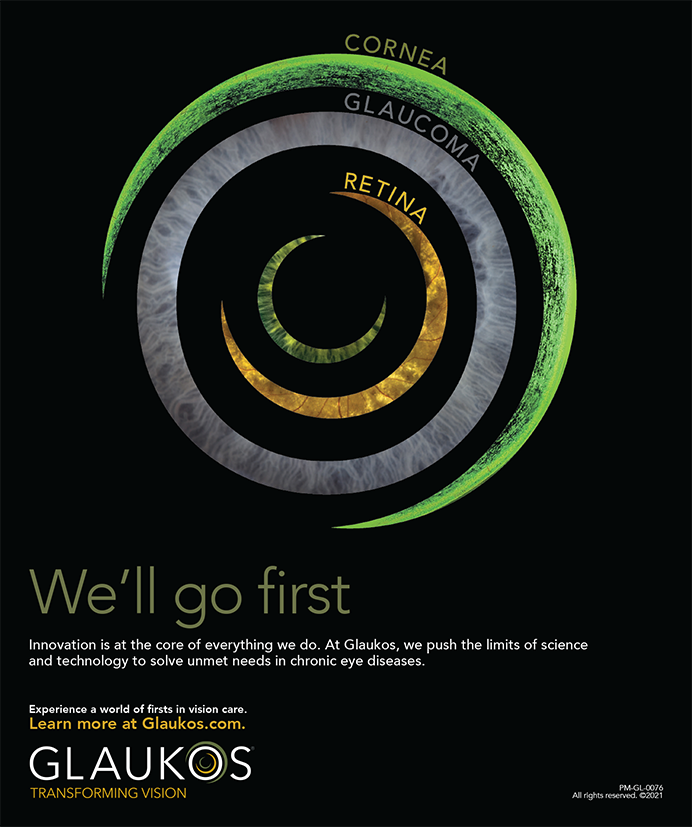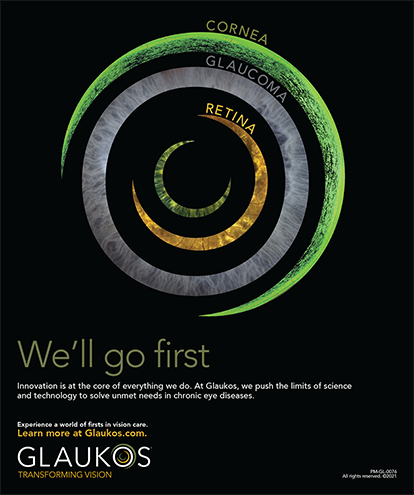CASE PRESENTATION
A 26-year-old female presented for refractive surgery with no preexisting conditions. Her past medical and ocular history was uneventful. She sought to reduce her need for contact lenses. Her preoperative refractions were -3.75 1.00 X89 OD and -4.25 1.25 X75 OS. Preoperative ultrasound pachymetry measured corneal thicknesses of 567 ?m OD and 572 ?m OS.
The surgeon created the LASIK flap with the IntraLase FS laser (Advanced Medical Optics, Inc., Santa Ana, CA) set at 110 ?m. Intraoperative pachymetry measured 460 ?m OD and 466 ?m OS. The LASIK procedure was seemingly uneventful.
On the first postoperative day, the patient's visual acuity measured 20/20 OD with a residual refractive error of plano. The vision in her left eye was blurry with a visual acuity of 20/80 and a residual refractive error of -1.50 2.50 X85. A review of the patient's surgical chart showed that the surgical plan for the patient's left eye was a treatment of -4.00 1.00 X155 and that an error in the axis accounted for her residual refractive error.
How would you handle this patient who is now concerned that her left eye does not see as well as her right?
STEPHEN F. BRINT, MD
This case underscores the need for surgeons to double-check the written surgical plan against the patient's chart for every eye they treat (preferably with the help of an independent observer such as the laser technician or optometrist involved) before the patient enters the laser suite. Surgeons should verify that the written surgical plan matches what is entered into the laser while the patient is on the table.
The mistake in this case occurs more often than one would like to think. It is usually due to a transposition from plus to minus cylinder, depending on the laser. For that reason, I like when possible to refract eyes in minus cylinder and keep everything in that format to help prevent these mistakes. This case may represent an error in data entry, however, because the axis of the left eye entered into the laser was 155° rather than 75°.
If this were a case of a true 90° error of transposition detected immediately, I would have calculated the anticipated induced cylinder as spherical error and corrected it at the time of the original surgery. Assuming that the problem was detected 1 day postoperatively when the patient's UCVA was 20/80 and the chart/laser entry was checked, I would tell the patient what had happened, express that I was just as upset by the mistake as she was, and prepare to correct the error as quickly as possible. I would explain that the goal would be to attain the high visual quality that she obtained in her right eye and tell her that there was plenty of residual tissue for the second ablation. I would underscore that her happiness was my only desire and that I would be at her side until our goal was achieved. I would give the patient my home and cell phone numbers for her and her family to call as needed. I would request that her relatives and/or spouse accompany her at her next visit if they were not with her for the 1-day examination so that I could explain everything to them as well, because patients are sometimes too anxious to understand the issues initially.
I would attempt the second ablation as soon as possible, especially if it were an error in transposition as opposed to a data entry error, for which the eye might need more time to stabilize for the final refraction. These actions and any other subsequent visits and treatments would be completed, of course, at no charge to the patient.
JAMES J. SALZ, MD
I would tell the patient that a programming error occurred when the astigmatic portion of her prescription was entered into the laser. I would explain that it resulted in residual astigmatism, which is why the vision in her left eye is blurry despite the properly entered amount of her myopia. I would further explain that, because she has adequate residual stroma under her flap, her remaining astigmatism can be fully corrected with another treatment in 3 or 4 weeks when her refractive error has stabilized. I would note that the retreatment would likely achieve the same excellent outcome she has experienced in her right eye.
I would offer to pay for her temporary glasses and inform her that the usual charges for an enhancement would be waived.
ADAM B. KRAFCZEK, ESQ
From a medicolegal perspective, your approach to managing this complication will ultimately determine the nature of the outcome?namely, a quick and amicable resolution or a long, expensive, and often painful lawsuit that typically occurs when patients are unhappy with their outcomes and do not feel they received the treatment they were promised. If you exacerbate their feelings of anger and abandonment, you will have the basic ingredients for a lawsuit. As a general rule, your actions immediately following a complication or unexpected outcome determine whether or not you and your practice end up in court.
For the purposes of this case, I will assume that the error in data entry and resulting complication were detected 1 day postoperatively. At that point, I would recommend that you investigate the cause of the complication as quickly as you could and that you be prepared to address the patient and her family openly and honestly. This conversation should cover not only what happened but also your suggested course of remedial action (in this case enhancement) and its associated risks and benefits. Do sympathize with the patient but avoid being overly apologetic or readily admitting to a mistake just to make the patient feel better, because these statements can be used against you. Accept responsibility for resolving the complication.
Document all of your conversations with the patient, any questions she asks, and your responses as contemporaneously as possible. Note the date and time of the conversations as well as the date and time your notes were taken. These notes often become critical evidence to prove that you did or did not say something, because patients often have faulty and/or selective recollections of events by the time a case makes its way to court.
Dr. Brint makes an excellent point when he states that he would give this patient his home and cell phone numbers for her or her family to call as needed. I recommend making every possible effort to be accessible to the patient. This behavior not only demonstrates your sympathy and care, but it helps the patient feel that she is a priority for you. Providing these phone numbers and accepting or promptly returning the patient's calls are often a simple way to make an overwhelmingly positive impact. Personal attention to the patient at this time is crucial, and effective communication is key to avoiding a legal confrontation.
You should also consider waivers/discounts of your fees. Although every situation and patient is different, I would agree with Drs. Brint's and Salz's suggestion in this case to perform at no charge any additional services/enhancements related to resolving the complication. Whether you refund all or a portion of the original fee for the procedure is a different matter and depends on the physician and individual patient. If this patient is difficult and/or demands a complete refund, you should seriously consider her request, because it is a small price to pay in order to avoid being sued. Consult with an attorney in connection with any discounts or refunds, have your legal counsel draft an appropriate release agreement, and require the patient to sign it. The document should provide that the patient waives her right to file a suit against you and releases you from any liability in connection with the complication in exchange for the refund, because a refund under these circumstances can be construed as an admission of liability. Ensure that the patient is represented by an attorney who explains the document to her before she signs it. Otherwise, the agreement can be deemed invalid if the patient later claims that she did not understand what she was signing or that she was waiving her right to bring a lawsuit.
Finally, contact your attorney and professional liability insurer, because, at this point, you will have done everything you could that is within your control.
The material presented in this article is intended for informational purposes only. It is not intended as legal advice or to serve as a substitute for a consultation with an experienced attorney or risk management professional. The laws of your particular state and your particular situation may affect the information contained herein. Consult a risk management professional and/or an attorney regarding your specific needs.
Section editor Karl G. Stonecipher, MD, is Director of Refractive Surgery at TLC in Greensboro, North Carolina. Parag A. Majmudar, MD, is Associate Professor, Cornea Service, Rush University Medical Center, Chicago Cornea Consultants, Ltd. Stephen Coleman, MD, is Director of Coleman Vision in Albuquerque, New Mexico. They may be reached at (336) 288-8523; stonenc@aol.com.
Stephen F. Brint, MD, is Associate Clinical Professor of Ophthalmology at Tulane University School of Medicine in New Orleans. He acknowledged no financial interest in the products or companies mentioned herein. Dr. Brint may be reached at (504) 888-2020; brintmd@aol.com.
Adam B. Krafczek, Esq, is a civil trial attorney with the Law Offices of Adam B. Krafczek. Attorney Krafczek is also Co-founder and Vice President of Bryn Mawr Communications LLC, publisher of Cataract & Refractive Surgery Today, and he is a frequent legal contributor to the publication. He acknowledged no financial interest in the products or companies mentioned herein. Attorney Krafczek may be reached at adam@bmctoday.com.
James J. Salz, MD, is Clinical Professor, Ophthalmology, University of Southern California, and is in private practice in Beverly Hills, California. He is on the board of directors of the Ophthalmic Mutual Insurance Company. Dr. Salz may be reached at (310) 360-0609; jjsalzeye@aol.com.


